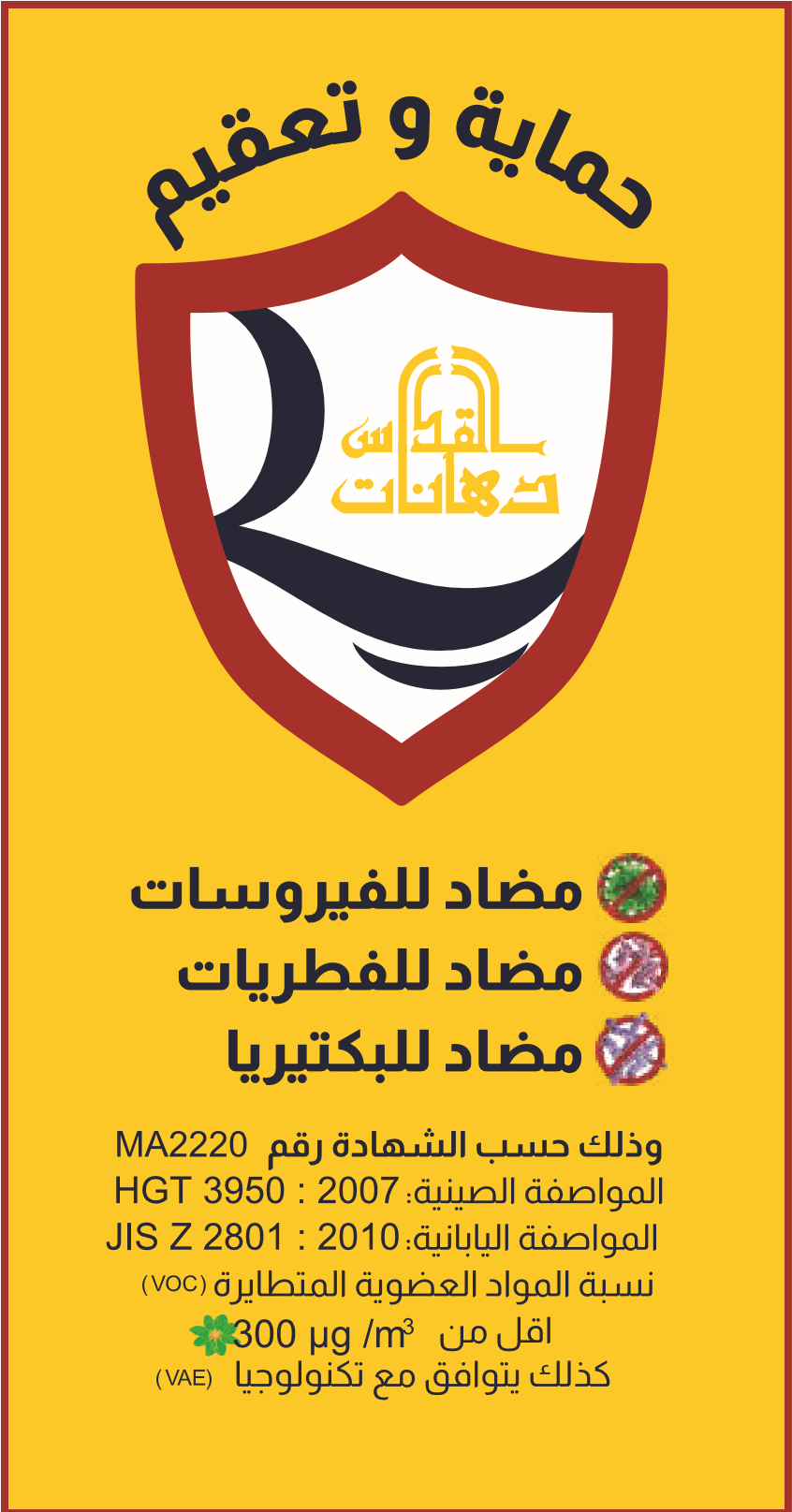تأسست صناعة دهانات القدس في عام 1994. وقد بدأت بخطين من المنتجات .

ما هي الدهانات المضادة للعفن والبكتيريا والفيروسات؟
ما هي الدهانات المضادة للعفن والبكتيريا والفيروسات؟
- أيلول 08, 2021
تكنولوجيا التعقيم
في العام 2020 استجابت شركة القدس لصناعة الدهانات إلى الأوضاع الصحية العالمية المستجدة، وقامت بتطوير منتجاتها بما يتناسب مع تلك الظروف الصحية الطارئة ،وبناءً عليه قامت بتطوير تكنولوجيا حماية صحية (تعقيم)في الطلاء الجاف على الجدران،(Dry Film Preservative Technology)وهي تكنولوجيا تقوم على إعتماد مدخلات إنتاج تجعل من طلاء الاسطح مقاومة ومضادة لإنتشار الفطريات والعفن والبكتيريا القاتلة والميكروبات والفيروسات المضرة بالصحة، بحيث يصبح الطلاء مادة فعالة حال طلائه على الجدران وجفافه، فيتم إستمرارالقضاءعلى الميكروبات والفطريات والفيروسات لفترة 24 شهر من تاريخ تطبيق الطلاء (بشرط مراعاة الظروف الموضوعية الوارد ذكرها آخر هذه المقدمة).
وهذه التكنولوجيا الحديثة لاتتعارض مع طبيعة الطلاءات التي تنتجها شركة القدس الصديقة للبيئة " VAE TECNOLOGY ,ECO-SMART "، والتي تضمن أعلى جودة هواء في المنزل بعد عملية الطلاء.وبالتالي فهي لاتؤثر على صحة ساكني البيت أو المنشئة .
كذلك فإن كلاً من تكنولوجيا التعقيم وصداقة البيئة لا تؤثران على جودة أداء الطلاء من ناحية التغطية والتستير ونصاعة البياض وقوة الطلاء وتماسكه أنسجاماً وتطابقاً مع المواصفة القياسية الأردنية للدهانات (31/2020)، والمواصفة القياسية الاوروبية رقم (EN 13300) .
تم تطوير هذه التكنولوجيا بالتعاون مع مختبرات أوروبية ,لتحقيق الغايات المبينة أعلاه، خاصةً لناحية الموائمة بين أداء المنتج ، وجودة الهواء وقدرة التعقيم .
تم إعتماد المواصفات العالمية التالية في تكنولوجيا التعقيم المستحدثة في دهانات القدس:
أولاً:
المواصفة اليابانية رقم JIS Z 2801:2010 :
تعد المواصفة القياسيةاليابانية JIS Z 2801:2010 أحد أكثر الاختبارات السطحية المضادة للميكروبات شيوعًا والمطلوبة والموثوقة للنشاط المضاد للبكتيريا وفعاليته.
تحدد المواصفة القياسية اليابانية خاصية مقاومة البكتيريا وطرق الاختبار لتقييم نشاط الطلاءالمضاد للبكتيريا وفعاليته ضد البكتيريا على الاسطح, وفعالية الطلاء المضاد للبكتيريا في الحالة الجافة لمقاومة نمو الكائنات الدقيقة بعد التطبيق ،حيث تحدد المواصفة مايلي :
1.تحديد طريقة تحضير العينة والوسط والظروف المعيارية للإختبار .
2.تحديد المعدات والادوات والمواد المستخدمة في الاختبار.
3.تحديد أنواع البكتيريا والسلالات البكتيرية المستخدمة بالفحص،وفي حالة دهانات القدس ، تم إعتماد عينات من بكتيريا :
Staphylococcus aureus (CECT 239) and Escherichia coli (CECT 516)
4.تحديد طريقة الفحص والاختبار لعينات الطلاء المضاد للبكتيريا، وفي هذه الحالة تم إعتماد الطلاءات التالية من شركة القدس:
-يلوكان فاينل سلك داخلي وخارجي.
ويتم إجراء الفحوصات والاختبارات في مختبرات معتمدة ومتخصصة تحقق متطلبات المواصفة القياسية اليابانية (JIS Z 2801:2010) .
وتتلخص طريقة الفحص بتحضير الوسط المناسب لعينة الطلاء المضاد للبكتيريا ، ضمن الظروف المحددة لنمو البكتيريا ومن ثم تلقيح سطح الطلاء المضاد للبكتيريا بأنواع البكتيريا المحددة في الفحص ضمن ظروف نمو البكتيريا المعيارية .
نتيجة الاختبار :
تحدد نتيجة الاختبار من خلال احتساب قيمة النشاط المضاد للبكتيريا (R) بإستخدام معادلات حسابية موضحة حسب المواصفة القياسية اليابانية JIS Z 2801:2010 بحيث أنه:
يجب ألا تقل قيمة نشاط المضاد للبكتيريا (R) الذي تم الحصول عليه بطرق الاختبار لهذه المواصفة القياسية عن 2.0 للفعالية المضادة للبكتيريا للمنتجات .
ويعتبرالطلاء منتج فعال ومضاد للبكتيريا في حال كانت قيمة (R) أكبر أو تساوي 2.
ثانيأ:
المواصفة الصينية HGT 3950:2007 :
تحدد المواصفة القياسية الصينية خاصية مقاومة البكتيريا وخاصية مقاومة العفن الفطري ،وطرق تقييم التأثير لمضادات البكتيريا والعفن والفطريات في الطلاء المضاد للبكتيريا .
يتم إجراء الإختبار وفقاً للطريقة المحددة بالمحلق (ب) المحدد بالمواصفة القياسية الصينيةHGT 3950:2007
في مختبرات متخصصة تستوفي متطلبات السلامة الحيوية للمختبر ، والظروف المعيارية لإجراء الاختبار.
حيث يتم تحضير العينة للاختبار حسب طريقة الفحص المحددة بالمواصفة وإختبارها ضمن ظروف الاختبار المحددة (ظروف نمو العفن والفطريات) .
مقياس التقييم المعتمد لنتيجة الفحص حسب المواصفة الصينية HGT 3950:
يتم الحكم على طريقة الفحص لعينة الطلاء من خلال المراقبة المباشرة بالعين المجردة للعينة لتحديد وتقييم مدى انتشار العفن والفطريات فيها.
يجب أن تحقق عينة الطلاء التي تم اختبارها، وفي هذه الحالة تم فحص منتجات القدس التالية :
-يلوكان فاينل سلك داخلي وخارجي.
متطلبات المواصفة القياسية الصينية HG 3950:2007 وفقا لمقياس تقييم نمو العفن والفطريات على سطح عينة الطلاء الذي حددته المواصفة الصينية:
الدرجة 0: لا يوجد نمو للعفن والفطريات على عينة الطلاء وبالتالي تعتبر عينة الطلاء ناجحه وتجتاز فحص المواصفة القياسية الصينية HGT 3950:2007 .
الدرجة 1: نمو العفن والفطريات بمساحة تغطية للعفن والفطريات بنسبة أقل من 10٪ على عينة الطلاء التي تم إختبارها وبالتالي لا تجتاز فحص المواصفة القياسية الصينية HGT3950:2007 .
الدرجة 2: نمو العفن والفطريات بمساحة تغطية للعفن والفطريات بنسبة أكبر من 10٪على عينة الطلاء التي تم إختبارها وبالتالي لا تجتاز فحص المواصفة القياسية الصينيةHGT 3950:2007.
وفي حال عدم تحقيق المنتج المضاد للعفن متطلبات الفحص في المواصفة القياسية الصينيةHGT 3950:2007 ،يتم الاحتفاظ بالعينة وإعادة الاختبار مرة اخرى .
وفي حال استمرار النتيجة سلباً في عدم تحقيق متطلبات المواصفة فأنه يحكم على الطلاء الذي تم فحصه بالفشل وغير مضاد للعفن والفطريات وعدم تلبيته لمتطلبات المواصفة الصينية المعياريةHGT 3950:2007.
وعليه فإن أي منتج من منتجات شركة القدس لصناعة الدهانات الذي يحمل العلامة التجارية المسجلة التالية:

فإنه يتمتع بقدرة تعقيمية وحماية ضد البكتيريا والعفن والفطريات وفقاً للمواصفة القياسية اليابانية JIS Z 2801:2010 والمواصفة القياسية الصينية HGT 3950:2007 .
علماً أن فعالية هذه العلامة التجارية والمنتج لا بد أن تستوفي شروط تطبيق موضوعية تتمثل في إعتبار الظروف التالية والتي تؤثر سلباً على فعالية التعقيم في المنتج:
1-التشقاقات وأي عيوب أخرى قد تكون موجودة على الاسطح.
2-الرطوبة العالية على الاسطح.
3-تكاثف بخار الماء على الاسطح خاصةً عندما يكون السطح بارداً.
4-التهوية السيئة او المعدومة في منطقة تطبيق الطلاء .
5-قلة التعرض لأشعة الشمس في مناطق تطبيق الطلاء.
6-الطلاء على الاسطح الرطبة













